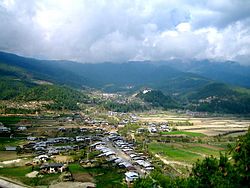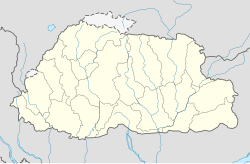| Jakar བྱ་ ཀར་ | ||
 | ||
| State | Bhutan | |
|---|---|---|
| Altitude | 2,587 m a.s.l. | |
| Prefix tel | 975 3 | |
| Time zone | UTC 6 | |
Position
| ||
Jakar (བྱ་ ཀར་) is the main administrative city of the Bumthang district in Central Bhutan.
To know
Spacious and surrounded by tree-covered mountains, the valley in which Jakar is located (Choekor Valley) is considered to be one of the most beautiful in all of Bhutan and is commonly referred to as the "Small SwitzerlandThe Jakar area is known as a bastion of Vajrayana Buddhism, especially the Nyingma tradition, and many monasteries and sacred sites are located here.
Below the dzong the group of villages, collectively known as "Jakar Town". The main bazaar was destroyed in three successive fires between 2010 and 2011 and currently consists of two rows of single-story structures. A new bazaar is under construction near the dzong.
When to go
Strong winds make Jakar a very cold place in winter, with temperatures often dropping as low as -6 ° C. The best time to visit the area is from the end of May until the end of September.
Background
Jakar was the first place in Bhutan visited by Guru Rinpoche and when the ruler of the region later converted to the Buddhism, Jakar was given the title of "cradle of Buddhism" in Bhutan. In addition, one of the most revered and skilled teachers of the Vajrayana Buddhist school, Pema Lingpa, was born in the Jakar area.
How to orient yourself
How to get
By bus
Meto Transport coastal buses depart daily from the bus station in Thimphu at 6:30. It's an 11-hour journey from the capital, and a one-way ticket costs less than 300 Nu. The bus doesn't stop until lunchtime, so it's important to pack some snacks.
How to get around
As tourism and pilgrimage sites are scattered throughout the area, a vehicle is essential for getting around.
By taxi
Taxis can be hired from the main bazaar.
What see


- Jakar Dzong (Jakar Yugyal Dzong). The fortress was originally built in 1667, but rebuilt after being severely damaged by an earthquake in 1897. It is one of the largest and most impressive dzongs in Bhutan and houses the administrative and monastic offices for the Bumthang district. Jakar Dzong means the "White Bird Fortress". Apparently, when a group of llamas were in the area looking for a suitable site for the new dzong, a single white bird kept circling before settling on the top of a hill. This was considered a good omen, and the hill was chosen as the site for the dzong and the white bird was adopted as its name.
- Wangdicholing Palace. Built in 1857, the palace was the main summer residence of the first and second kings of Bhutan. It is an unassuming structure, devoid of the ramparts and protective walls that have become standard features of later buildings. Currently, it is not busy and can be visited.
Monasteries are referred to by their title Dzongkha of lhakhang or goemba (sometimes gompa, meaning temple).
- Kurjey Lhakhang (Kurje Lhakhang too). One of the holiest monasteries in Bhutan. A body print of Guru Rinpoche is kept in a cave around which the oldest of the three buildings is built. The original building was built in 1652 by Trongsa Penlop, while the latest addition was commissioned by the late Queen Mother Ashi Kesang Wangchuk in 1990. A huge cypress tree (or possibly a falling tree) above the building is said to have grown. from Guru Rinpoche's walking stick.
- Zangtopelri Lhakhang. Consecrated in 2008, this latest addition to the area's sacred sites houses a two-story tall mandala representing Guru Rinpoche's copper-colored mountain. Zangtopelri is within walking distance of Kurjey Lhakhang.
- Jambay Lhakhang. One of 108 monasteries miraculously built by King Songten Gampo in one night. The monastery is located between Kurjey Lhakhang and Jakar Dzong.
- Lhodrak Kharchhu Lhakhang. This monastery is a more recent addition to the pantheon of Jakar monasteries and is located above the city. Abbot Namkhai Nyingpo Rinpoche is a highly regarded teacher in Bhutan and speaks a little about English.
- Tamshing Goemba (Sometimes Tamshing Gompa). A monastery founded in 1501 by the local Buddhist saint Pema Lingpa. The two story building contains some lovely frescoes, and has a very low ceiling (apparently Pema Lingpa was very low!) Also, there is a 500 year old metal chain made by Pema Lingpa located on the first floor. It is considered a good omen to circumscribe the temple three times with the chain draped over the back and shoulders.
- Chakhar Lhakhang (Iron castle). This small and modest temple marks the site of the palace of Sindhu Raja, the monarch Indian who first invited Guru Rinpoche to Bhutan. The original palace is said to have been made of iron and nine stories high. The current building was built by Dorji Lingpa in the 14th century.
Events and parties
Being an area famous for its monasteries and sacred sites, Jakar hosts numerous tshechu (religious festivals) throughout the year. The highlight of a tshechu are the masked dances conducted by the monks, which were developed following precise instructions given by Buddhist masters of the past. According to Buddhist philosophy, all experiences leave an imprint in the mind stream that produces a corresponding result in the future, and therefore seeing dances like these that are imbued with sacred symbolism is considered a very promising and sanctifying experience. Although the event does not take place in a solemn atmosphere and there is a lot of cheer, visitors are reminded that it is still a religious festival that has great significance in the lives of Bhutanese, and therefore appropriate behavior is required.
- Domkhar Tshechu. It takes place in Domkhar Lhakhang.
- Nimalung Festival.
- Kurjey Tshechu.
- Tamshing Phala Choedpa. It takes place in the Tamshing Lhakhang.
- Jakar Tshechu. It takes place in Jakar Dzong.
- Jambay Lhakhang festival.
What to do
Shopping
The main bazaar (Chamkhar) was badly damaged in a fire on 26 October 2010. However, temporary structures have been built on the site and therefore buying everyday items should not be a problem in the city. An alternative is the newer Dekiling bazaar.
The things that are normally sold are:
- Articles in woven wool (yethra) - Garments, carpets and bags woven with brightly colored wool are a unique product of the Jakar area and are highly regarded throughout the kingdom.
- Dzo cheese (female yak) e preserves.
- Wood carvings
The main places to shop are:
- Souvenir shops. There are a couple of craft shops in the main bazaar, and all the tourist hotels offer a wide selection of local products.
- Emporium of craftsmanship (Handicraft Emporium) (Near the Wangdicholing palace). A government-run shop that sells handicrafts from all over Bhutan, but with a focus on local Bumthang products. Prices are not negotiable.
- Udee Woodcarving Workshop. Make traditional Bhutanese furniture and artifacts.
- Traditional paper factory (Near Lame goemba).
- Lham shop (Located in the bazaar). A type of deli where they sell cheese cut from the shape and various types of apple products, such as fruit juice, wine and brandy.
How to have fun
Where to eat
Most of the tourist hotels in Jakar offer local and international cuisine and coffee, tea and alcohol are served to drink.
The apple juices are fresh because they come from the famous orchards of Jakar.
Moderate prices
- 11-7 (In the main bazaar). A small cafe serving latte, cappuccino and other filter-based coffees.
Average prices
- Himalayan Pizza (Just outside the main bazaar). Opened by a local guy who studied in Germany. It serves pizza and spaghetti.
- Tashi restaurant (Under the dzong). It serves simple local dishes, such as ema datshi and cheese and meat momo.
- Hotel Deki (Under the dzong). It serves simple meals.
Where stay
Average prices
- The Swiss Guest House (Located above the river overlooking the city and the dzong), ☎ 975 3 631-145, fax: 975 3 631-918, @[email protected]. Surrounded by apple orchards and beautifully decorated, this hotel offers an ideal situation to relax and unwind. An added attraction is draft beer - a rare commodity in Bhutan.
- Mipham Guest House (Located across the river from the main bazaar and just below the Lhodrak Kharchhu monastery).
 _1.250 Nu., Double: 1.350 Nu.. This stone and wood building offers wood burning stoves in all its rooms and spectacular views across the valley to Jakar Dzong.
_1.250 Nu., Double: 1.350 Nu.. This stone and wood building offers wood burning stoves in all its rooms and spectacular views across the valley to Jakar Dzong. - Wangdicholing Guest House, ☎ 975 3 631-107, fax: 975 3 631-138. A recently rebuilt lodge that offers great views over the valley.
- Kaila Lodge, ☎ 975 3 631-219, fax: 975 3 631-247. Decorated in a classic style and convenient for the city center.
- Jakar Village Lodge (Located under the dzong), ☎ 975 3 631-242, fax: 975 3 631-377. This hotel is famous for its excellent food.
- Yugharling Resort (Located near the city), ☎ 975 3 631602. Good facilities and stunning views.
High prices
- Amankora Bumthang (Located in an apple orchard next to the Wangdicholing palace), ☎ 975 2-331333, @[email protected].
 1,000 USD. An ecological lodge managed by the super luxury hotel group Aman. The 16-room property offers spa and international cuisine.
1,000 USD. An ecological lodge managed by the super luxury hotel group Aman. The 16-room property offers spa and international cuisine.
Safety
How to keep in touch
Around
- Chhume - A village famous for its woolen fabrics. This is the best place to buy a souvenir and watch the weaving process.
- Baths of Duer - A day trek starting from the road. The trek is arduous, but extraordinarily beautiful. Blue sheep, musk deer and Himalayan bears are common in the Duer spa area.
- Kunzang Drak - The Pema Lingpa retreat center a Tang. It is about an hour's walk from the main road through the Tang Valley.
- Mebar Tsho - Called the "lake of fire", it is a place where some of Guru Rinpoche's scriptural treasures (terma) were discovered in Tang in the 15th century by the famous treasure hunter Pema Lingpa.
- Tharpaling Goemba - Founded in Chhume by the dzogchen master Longchen Rabjam in 1352, the monastery also hosted the famous guru Nyingma Jigme Lingpa in the 18th century. It is located at 3,600 meters and is home to about 150 monks. It can be reached by a dirt road.
- Ura - With its cobbled streets and the monastery nestled between the snow-capped peaks at 3,100 m. Ura has a usually quiet and gentle charm.

